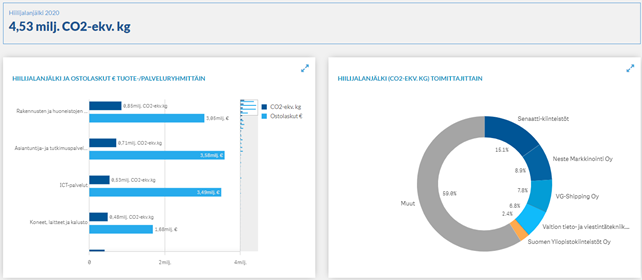Measured responsibility
The Procurement Pulse service, introduced in 2018, was given a new dimension in 2020, when a tab for the carbon footprint of procurement was added. From the tab, the procurement unit can see which product and service groups cause the most climate emissions, and then plan actions to reduce emissions where they will have the biggest impact. The tab also mentions the suppliers whose products or services cause the most emissions for the procurement unit, so that the procurement unit can discuss the matter with the supplier and ask what they are doing to reduce emissions, or if there is something else they could do.
The image below on the left shows how the procurement unit’s largest amount of emissions come from renting buildings and apartments. The image on the right also supports this, in which the Senate Properties is the supplier that causes the most emissions. In renting, the factors that cause the most emissions are usually electricity and heating. In discussions with the Senate Properties, the customer would probably find out that the Senate Properties buys zero-emission electricity from a verified source and they have an installation programme for solar panels, but that there is perhaps something they could do more.

The next product and service group is the specialist and research services, in which emission reduction is perhaps more challenging and consists of small streams. However, it is possible to demand them as well to acknowledge environmental issues with an offer request. The second on the supplier side is Neste Markkinointi Oy and fuel and lubricant purchases, in which the reduction of emissions is fairly straightforward by reducing the use and changing to renewable fuels, if possible.
The average carbon footprint of a Finn is 10,000 kg per year, so this procurement unit’s 4,530,000 kg CO2e corresponds to the emissions of approximately 450 Finns.
The carbon footprints of procurement projects, i.e., the life cycle greenhouse gas emissions, have been calculated with the ENVIMAT model created by the Finnish Environment Institute. The emissions readings are the averages of products and services used in Finland, so they cannot be used to compare emissions from the products and services of different companies, for example, or the emissions of a company’s two different products or services. This is a potential development target for future years. The first development step towards this has already been taken, when those customers that buy electricity from a verified source moved to zero emissions from Finland’s average. If future joint procurement projects were to oblige suppliers to report on the carbon footprint of their products or services, this information could easily be added to the Procurement Pulse, which would again help achieve a better level than the average.
Read next: We support healthy competition
